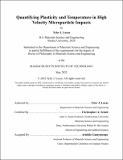Quantifying Plasticity and Temperature in High Velocity Microparticle Impacts
Author(s)
Lucas, Tyler J.
DownloadThesis PDF (6.639Mb)
Advisor
Schuh, Christopher A.
Terms of use
Metadata
Show full item recordAbstract
The Laser Induced Particle Impact Test, or LIPIT, is a benchtop experimental setup that enables in-situ observation of micron-scale particles impacting targets at velocities ~10-1500 m/s. Through a combination of the high velocity and small length-scale of the impact, strain rates exceeding 10⁷ /s can be achieved while maintaining a subsonic plastic wave, preventing formation of strong shockwaves and hydrodynamic behavior. The LIPIT has been effectively applied to study phenomena in mechanical behavior, cold spray, and astronomical impacts, all of which will be further investigated in this work. This thesis combines LIPIT experiments and finite element modeling to explore the dynamic behavior of pure metals in the unique regime of strain, strain rate, and pressure achieved in high velocity impact conditions. First, the effect of material microstructure on the mechanical behavior of copper at high strain rates is explored to improve the capability of constitutive strength models in accurately representing experiments. Next, a method is introduced to measure the dynamic yield strength of ductile microparticles, effectively removing the need for the tacit assumption that the properties of bulk materials can be imposed on powders despite differences in processing. The understanding of microstructure and particle behavior are then combined to study the influence of material microstructure on the solid-state bonding of copper particles to copper substrates of different temper. Finally, this work applies the new understanding of plasticity and dynamic modeling in high strain rate conditions to quantitatively study the behavior of metals with a phase transition in absence of strong shockwaves.
Date issued
2025-05Department
Massachusetts Institute of Technology. Department of Materials Science and EngineeringPublisher
Massachusetts Institute of Technology